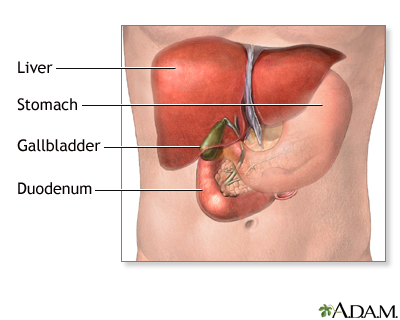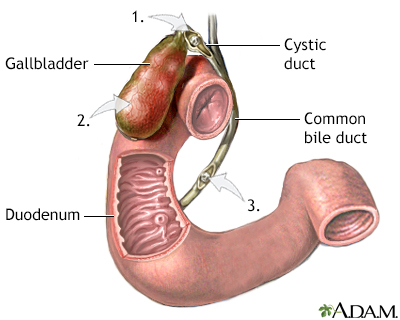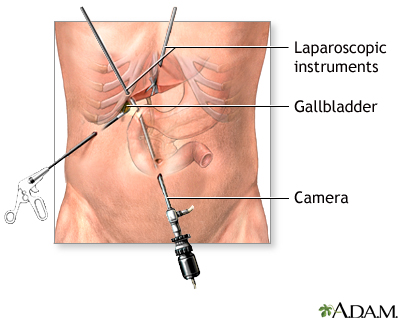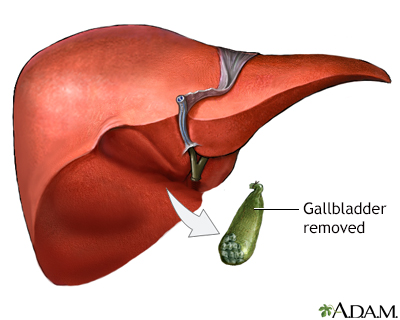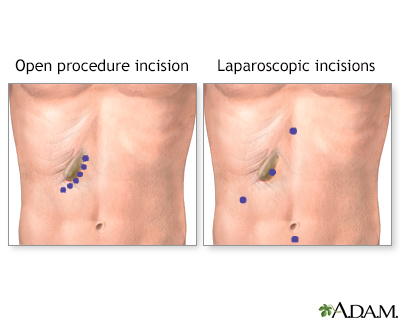Acute cholecystitis
Acute cholecystitis is sudden swelling and irritation of the gallbladder. It causes severe belly pain.
Causes
The gallbladder is an organ that sits below the liver. It stores bile, which is produced in the liver. Your body uses bile to digest fats in the small intestine.
Acute cholecystitis occurs when bile becomes trapped in the gallbladder. This often happens because a gallstone blocks the cystic duct, the tube through which bile travels into and out of the gallbladder. When a stone blocks this duct, bile builds up, causing irritation and pressure in the gallbladder. This can lead to swelling and infection.
Gallstone
Gallstones are hard deposits that form inside the gallbladder. These may be as small as a grain of sand or as large as a golf ball.

Other causes include:
- Serious illnesses, such as HIV or diabetes
Diabetes
Diabetes is a long-term (chronic) disease in which the body cannot regulate the amount of sugar in the blood.
 ImageRead Article Now Book Mark Article
ImageRead Article Now Book Mark Article - Tumors of the gallbladder (rare)
Some people are more at risk for gallstones. Risk factors include:
- Being female
- Pregnancy
- Hormone therapy
- Older age
- Being Native American or Hispanic
- Obesity
- Losing or gaining weight rapidly
- Diabetes
Sometimes, the bile duct becomes blocked temporarily. When this occurs repeatedly, it can lead to long-term (chronic) cholecystitis. This is swelling and irritation that continues over time. Eventually, the gallbladder becomes thick and hard. It does not store and release bile as well as it did.
Symptoms
The main symptom of acute cholecystitis is pain in the upper right side or upper middle of your belly that usually lasts at least 30 minutes. You may feel:
- Sharp, cramping, or dull pain
- Steady pain
- Pain that spreads to your back or below your right shoulder blade
- Pain that occurs after a meal, more commonly after a fatty meal
Other symptoms that may occur include:
- Clay-colored stools
- Fever
- Nausea and vomiting
Nausea and vomiting
Nausea is feeling an urge to vomit. It is often called "being sick to your stomach. "Vomiting or throwing-up forces the contents of the stomach up t...
 ImageRead Article Now Book Mark Article
ImageRead Article Now Book Mark Article - Yellowing of the skin and whites of the eyes (jaundice)
Exams and Tests
Your health care provider will perform a physical exam and ask about your symptoms. During the physical exam, you will likely have pain when the provider pushes on your belly.
Your provider may order the following blood tests:
- Amylase and lipase
- Bilirubin
- Complete blood count (CBC)
Complete blood count
A complete blood count (CBC) test measures the following:The number of white blood cells (WBC count)The number of red blood cells (RBC count)The numb...
 ImageRead Article Now Book Mark Article
ImageRead Article Now Book Mark Article - Liver function tests
Imaging tests can show gallstones or inflammation. You may have one or more of these tests:
- Abdominal ultrasound
Abdominal ultrasound
Abdominal ultrasound is a type of imaging test. It is used to look at organs in the abdomen, including the liver, gallbladder, pancreas, and kidneys...
 ImageRead Article Now Book Mark Article
ImageRead Article Now Book Mark Article - Abdominal CT scan or MRI scan
Abdominal CT scan
An abdominal CT scan is an imaging test that uses x-rays to create cross-sectional pictures of the belly area. CT stands for computed tomography....
 ImageRead Article Now Book Mark Article
ImageRead Article Now Book Mark ArticleMRI scan
A magnetic resonance imaging (MRI) scan is an imaging test that uses powerful magnets and radio waves to create pictures of the body. It does not us...
 ImageRead Article Now Book Mark Article
ImageRead Article Now Book Mark Article - Abdominal x-ray
Abdominal x-ray
An abdominal x-ray is an imaging test to look at organs and structures in the abdomen. Organs include the liver, spleen, stomach, and intestines. T...
 ImageRead Article Now Book Mark Article
ImageRead Article Now Book Mark Article - Gallbladder radionuclide scan
Gallbladder radionuclide scan
Gallbladder radionuclide scan is a test that uses radioactive material to check gallbladder function. It is also used to look for bile duct blockage...
 ImageRead Article Now Book Mark Article
ImageRead Article Now Book Mark Article
Treatment
If you have severe belly pain, seek medical attention right away.
In the emergency room, you'll be given fluids through a vein. You may also be given antibiotics to fight infection.
Cholecystitis may clear up on its own. However, if you have gallstones, you will probably need surgery to remove your gallbladder.
Surgery to remove your gallbladder
Open gallbladder removal is surgery to remove the gallbladder through a large cut in your abdomen. The gallbladder is an organ that sits below the li...

Nonsurgical treatment includes:
- Antibiotics you take at home to fight infection
- Low-fat diet (if you are able to eat)
- Pain medicines
You may need emergency surgery if you have complications such as:
- Tissue death (gangrene) of the gallbladder
- A hole that forms in the wall of the gallbladder (perforation)
- Inflamed pancreas (pancreatitis)
- Persistent bile duct blockage
- Infection due to a stone in the common bile duct -- also known as cholangitis
If you are very ill, a tube may be placed through your belly into your gallbladder to drain it. Once you feel better, your provider may recommend that you have surgery.
Outlook (Prognosis)
Most people who have surgery to remove their gallbladder recover completely.
Possible Complications
Untreated, cholecystitis may lead to any of the following health problems:
- Empyema (pus in the gallbladder)
Empyema
Empyema is a collection of pus in the space between the lung and the inner surface of the chest wall (pleural space).
 ImageRead Article Now Book Mark Article
ImageRead Article Now Book Mark Article - Gangrene
- Injury to the bile ducts draining the liver (may occur after gallbladder surgery)
- Pancreatitis
- Perforation
- Peritonitis (inflammation of the lining of the abdomen)
When to Contact a Medical Professional
Contact your provider if you have:
- Severe belly pain that does not go away
- Symptoms of cholecystitis return
Prevention
Removing the gallbladder and gallstones will prevent further attacks.
Reviewed By
Todd Eisner, MD, Private practice specializing in Gastroenterology in Boca Raton and Delray Beach, Florida at Gastroenterology Consultants of Boca Raton. Affiliate Assistant Professor, Florida Atlantic University School of Medicine. Review provided by VeriMed Healthcare Network. Also reviewed by David C. Dugdale, MD, Medical Director, Brenda Conaway, Editorial Director, and the A.D.A.M. Editorial team.
Clary B, Broderick R, Schaeffer AB, Moffett J, White R. Biliary system. In: Tyler DS, Hayes-Dixon A, Hines J, et al, eds. Sabiston Textbook of Surgery. 22nd ed. Philadelphia, PA: Elsevier; 2026:chap 88.
Fogel EL, Sherman S. Diseases of the gallbladder and bile ducts. In: Goldman L, Cooney KA, eds. Goldman-Cecil Medicine. 27th ed. Philadelphia, PA: Elsevier; 2024:chap 141.
Glasgow RE. Treatment of gallstone disease. In: Feldman M, Friedman LS, Brandt LJ, eds. Sleisenger and Fordtran's Gastrointestinal and Liver Disease. 11th ed. Philadelphia, PA: Elsevier; 2021:chap 66.
Wang DQ-H, Afdhal NH. Gallstone disease. In: Feldman M, Friedman LS, Brandt LJ, eds. Sleisenger and Fordtran's Gastrointestinal and Liver Disease. 11th ed. Philadelphia, PA: Elsevier; 2021:chap 65.










